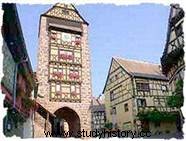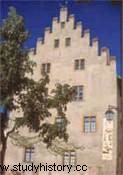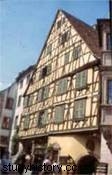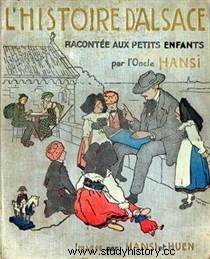 Riquewihr , ancient medieval city , is a small town located between the Vosges and Alsace, in the heart of the vineyards, ranked among the “most beautiful villages in France”. Flowered in summer with the traditional geranium, it adorns itself with its decorations during the Christmas period to welcome the two million annual visitors. The city, which extends over a rectangle of two hundred by three hundred meters, has around ten sites and monuments classified as Historic Monuments, as well as around forty houses and buildings listed on the additional inventory of Historic Monuments. In 1898 the Riquewihr Archaeological Society was founded in order to preserve its heritage, i.e. to prevent the destruction of old houses and to restore them.
Riquewihr , ancient medieval city , is a small town located between the Vosges and Alsace, in the heart of the vineyards, ranked among the “most beautiful villages in France”. Flowered in summer with the traditional geranium, it adorns itself with its decorations during the Christmas period to welcome the two million annual visitors. The city, which extends over a rectangle of two hundred by three hundred meters, has around ten sites and monuments classified as Historic Monuments, as well as around forty houses and buildings listed on the additional inventory of Historic Monuments. In 1898 the Riquewihr Archaeological Society was founded in order to preserve its heritage, i.e. to prevent the destruction of old houses and to restore them.
The story of Riquewihr
It all started in the 6th century when “Richo” Frankish owner exploited the site. A little later, the name is transformed into "Richovilla", then "Ricovilare" and finally "Riquewihr" around 1094. Possession of the counts of Horbourg, they build a wall in 1291, to protect the inhabitants and their property against invaders and the village became a town in 1320. Belonging to the county of Montbéliard following a marriage, the town passed to the Württembergs. It will become rich in the 16th century thanks to the vineyard, but also experiences hours of misery:Austrian domination, plague epidemics. The castle was rebuilt in 1540, a second enclosure ensured more security for the town which thus became a seigniorial residence.
During the 17th century, it was prosperity and the bourgeois, feeling safe, built very beautiful stone houses with storefronts and pretty balconies in wood or with visible beams. There is no shortage of materials:sandstone from the Vosges and fir trees. They thus produced sculptures, moldings, doors with capitals and arabesques, mullions of windows in the Renaissance style, stair railings, balustrades, and launched the fashion for flowered balconies, despite the passage and looting of armies. during the Thirty Years' War.
Attached to France in 1796 because the Württembergs had to abandon their possessions on the left bank of the Rhine, the city suffered practically no damage during the two world wars. Riquewihr can thus continue its reputation thanks to the exploitation of its vines which produce muscats, famous Gewurztraminer and fine Riesling.
The city tour
When you enter the old town through the lower door, you pass under the porch of the Town Hall.
 Not far from there, on the left, was built in the middle of the 16th century the Württemberg castle which houses since 1970, the Museum of Communication in Alsace, retracing two thousand years of history of Posts and Telecommunications with presentation of uniforms, stamps, devices, vehicle, all being installed in a stable of the XVI th century.
Not far from there, on the left, was built in the middle of the 16th century the Württemberg castle which houses since 1970, the Museum of Communication in Alsace, retracing two thousand years of history of Posts and Telecommunications with presentation of uniforms, stamps, devices, vehicle, all being installed in a stable of the XVI th century.
In 1324, the count of Württemberg acquired the seigneury of Riquewihr, a marriage made the alliance with the county of Montbéliard. After passing under Austrian supervision, a new castle was built in 1540 with a crenellated gable, crowned with deer antlers and Renaissance windows. In the neighboring building, the count installed the chancellery. The castle remains unoccupied between 1723 and 1748 because it is placed under sequestration by the king. After this date, returned to grace, the lords of Württemberg took the name of lords of Riquewihr and settled there again until the revolution. The castle passes through private hands until the beginning of the 20th century when the city buys it and installs a school there which will be sometimes French, sometimes German!
Let's go up the main street, rue du General de Gaulle. All along, on both sides, we discover narrow streets, provided with taverns and beautiful half-timbered houses. We arrive at the top of the city at the Porte Haute, not far from the Tour du Dolder. This door dates from the 1300s. Under the passage, we discover the double leaf door and the wooden portcullis. From the 16th century, the first enclosure proved insufficient and the Duke of Württemberg therefore decided to build a second enclosure to better protect the villagers. This is how the drawbridge is built, the upper and lower city gates, defensive towers, bastions added in 1621 and a wide moat outside. Let's cross the passage and admire this landscape of vines...
 Retracing our steps, just at the Porte Haute, let's stop in front of the Dolder Tower. This tower was built at the same time as the ramparts in 1291. Twenty-five meters high, it served as a defense tower, a watchtower and represents the emblem of the city. Its exterior appearance was designed to threaten the enemy, while its physical appearance inside the village was prettier with its wooden beams and its four corbelled floors. In the 16th century, a guard lived there and had the task of closing the doors in the evening, warning of fire or enemies and ensuring the lookout. Since 1911, the City Museum has been located there. We discover daily life since medieval times with Merovingian remains, weapons from the 15th century to the 18th century, the life of the watchman-watchman-porter, costumes and tools relating to wine. On the fourth floor, the view over the rooftops of the city is superb.
Retracing our steps, just at the Porte Haute, let's stop in front of the Dolder Tower. This tower was built at the same time as the ramparts in 1291. Twenty-five meters high, it served as a defense tower, a watchtower and represents the emblem of the city. Its exterior appearance was designed to threaten the enemy, while its physical appearance inside the village was prettier with its wooden beams and its four corbelled floors. In the 16th century, a guard lived there and had the task of closing the doors in the evening, warning of fire or enemies and ensuring the lookout. Since 1911, the City Museum has been located there. We discover daily life since medieval times with Merovingian remains, weapons from the 15th century to the 18th century, the life of the watchman-watchman-porter, costumes and tools relating to wine. On the fourth floor, the view over the rooftops of the city is superb.
At the foot of the Dolder tower is the Fountain of the Sinne, installed in the 16th century. This fountain was used to clean barrels, barrels, and all containers used by winegrowers. The central column bears on one side the coat of arms of the lords of Horbourg and on the other the coat of arms of Riquewihr – a mixture of Horbourg and Württemberg coats of arms.
Before continuing the historical visit, a short stop is essential in the shop "La Féerie de Noël" which will seem curious to you in the middle of summer:The Nutcracker awaits you at the entrance to this store whose window is illuminated and the Christmas tree decorated... all year round!
 Going down the main street, on the left, take the street of the Jews, the old ghetto and we arrive on the Tower of Thieves. This tower, attached to the 13th century fortifications, with walls two to five meters thick and eighteen meters high, is one of the main defenses of the city. It was transformed into a place of exercise of justice and a prison in the 15th century. In this place of torture, those guilty of wrongdoing were subject to questioning. We can visit the torture chamber and in its center we come across the five-meter-deep dungeon, as well as the reconstruction of the guard's room. On the upper floor is the room of the guards and clerks with an exhibition of the instruments of torture used. Adjoining the guard room, we pass through the Maison du Vigneron dating from the 16th century where all the tools of the winegrowers and coopers are displayed.
Going down the main street, on the left, take the street of the Jews, the old ghetto and we arrive on the Tower of Thieves. This tower, attached to the 13th century fortifications, with walls two to five meters thick and eighteen meters high, is one of the main defenses of the city. It was transformed into a place of exercise of justice and a prison in the 15th century. In this place of torture, those guilty of wrongdoing were subject to questioning. We can visit the torture chamber and in its center we come across the five-meter-deep dungeon, as well as the reconstruction of the guard's room. On the upper floor is the room of the guards and clerks with an exhibition of the instruments of torture used. Adjoining the guard room, we pass through the Maison du Vigneron dating from the 16th century where all the tools of the winegrowers and coopers are displayed.
A little further down, halfway down the main street, still to the left, we come to the Place des Trois Eglises. Originally, this square was framed by three religious buildings. At the time of the reform in 1534, the buildings were transformed, one into a Protestant temple, the other into a school. Demolished in 1845, two new churches were built (the Protestant in the same location, the Catholic towards the Porte Neuve).
 Let's go down the main street again and stop at the Hansi House. Jean-Jacques Waltz, nicknamed Uncle Hansi was born in February 1873 in Colmar, then a German city. A bad student, he preferred drawing and published his first card around 1896 when Colmar discovered postcards. His success was great when he published a collection of plates called "images of the Vosges". But the greatest was the "History of Alsace told to the children of France" in 1912. His literary works as well as his satirical and anti-Germanic drawings will earn him to go before the German courts. For a few years around 1930, he worked in advertising, notably for Potasses d'Alsace. During the Second World War, his ideas and drawings being always anti-Germanic, he had to take refuge in Agen. Back in Colmar, he died in June 1951. His drawings and watercolors can be found on stained glass windows, dishes, posters, programs, books and around four hundred postcards. A multifaceted artist, he was also an engraver, writer and historian. The “Au nid de cigognes” museum pays tribute to him by exhibiting more than one hundred and fifty works.
Let's go down the main street again and stop at the Hansi House. Jean-Jacques Waltz, nicknamed Uncle Hansi was born in February 1873 in Colmar, then a German city. A bad student, he preferred drawing and published his first card around 1896 when Colmar discovered postcards. His success was great when he published a collection of plates called "images of the Vosges". But the greatest was the "History of Alsace told to the children of France" in 1912. His literary works as well as his satirical and anti-Germanic drawings will earn him to go before the German courts. For a few years around 1930, he worked in advertising, notably for Potasses d'Alsace. During the Second World War, his ideas and drawings being always anti-Germanic, he had to take refuge in Agen. Back in Colmar, he died in June 1951. His drawings and watercolors can be found on stained glass windows, dishes, posters, programs, books and around four hundred postcards. A multifaceted artist, he was also an engraver, writer and historian. The “Au nid de cigognes” museum pays tribute to him by exhibiting more than one hundred and fifty works.
The main buildings having been visited, we go down to the Town Hall. Until the Revolution, this building was in the center of the village, in the main street. Moved, it was rebuilt at the current location in 1809.
After a nice walk, we leave Riquewihr, nicknamed "the Pearl of the Vineyard", this town which has best preserved its Alsatian-style houses, half-timbered, oriel windows and interior courtyards lined with wells and fountains, as well as its ramparts surrounding the site.
